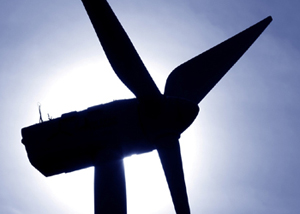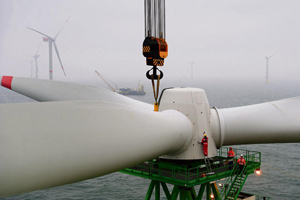German offshore wind industry sees sunshine behind the clouds
on
German offshore wind industry sees sunshine behind the clouds
Offshore wind energy is envisioned to play a key role in Germany's Energiewende. The German government wants to see 25,000 megawatts of offshore wind parks installed in the Baltic and North Seas - the equivalent of 20 large nuclear power reactors. But unclarity over the transmission grid and regulatory issues has slowed progress. Nevertheless at a recent conference in Hamburg, the industry's leading representatives sounded an optimistic note. They said crucial legislation is finally coming into place that will enable them to proceed with their ambitious offshore plans.
 |
| Offshore wind in Germany has relatively little to show for itself (c) Energy Live News |
Grid plan
In the aftermath of Fukushima, the Merkel administration announced that offshore wind would have to weigh in substantially to fill the void left by nuclear power and to meet Germany’s ambitious climate and renewable goals. Under the plan, Germany would tap the enormous potential of the North and Baltic seas with an unprecedented investment in gigantic wind parks. The government wants to have 7.6 gigawatts (7600 megawatts) of capacity installed by 2020 and as much as 26 gigawatts by 2030 – the equivalent of over 20 nuclear power plants. In total, the farms would cover a patch of sea eight times as large as New York City.
Today the combined generation power of Germany's offshore capacity is only a meager 200 megawatts. To compare: total installed offshore wind capacity in the EU was 3,000 megawatts at the end of 2010. Unlike in onshore wind, where Germany is the largest market, in offshore the UK and Denmark are market leaders.
But Germany has every intention to catch up. Currently under construction in the German seas are offshore wind farms with a total capacity of about 1,100 megawatts. Wind farms with a capacity of 9,000 to around 10,500 megawatts have received authorization. Moreover, another 94 projects with a total capacity of up to about 30,000 megawatts are in the process of being authorized.
Until very recently, the industry was stopped in its tracks. Exactly what and who is to blame for the snail's pace of offshore wind is a matter of contention. The main - but not the only - issue is construction of the
| Exactly what and who is to blame for the snail's pace of offshore wind is a matter of contention |
Bombshell
But even in the absence of a reliable grid plan and clear regulatory structures, initial grid connections were being built - until they were halted late last year. Transmission system operator (TSO) TenneT was contracted to build nine transmission stations, essentially "sockets", in the North Sea that nearby clusters of projects could plug into, as well as three converter platforms that would link the transmission stations and utilities on land.
The converter platforms are enormous constructions that collect the alternating current generated by the turbines, convert it into high-voltage direct current, and transmit it to land via cable. (The Baltic's wind farms, not so distant from the coast as those in the North Sea, will be linked to shore via alternating-current connections, not converter stations.) But in November 2011 TenneT informed the government it could not deliver the platforms on time. It said it lacked the money, the high-voltage direct-current components, and the properly skilled personnel.
With this bombshell, the grandiose plans were put on hold. Observers predicted that the grid delays would mean that Germany would miss its 2020 and 2030 offshore targets - the question was only by how much.
"TenneT was simply overwhelmed by the huge demands that were asked of it," says Markus Rieck, Country Sales Director of Alstom in Germany, a company producing turbines and electrical equipment. "It was a mixture of problems with many origins. Now things are getting better but it introduced some fear and uncertainty into the market, fear that offshore wouldn't take off like planned."
Offshore Dialogue
Rieck and his fellow experts who gathered recently at the SMM's Offshore Dialogue 2012 Conference in Hamburg agreed that key obstacles have been removed - or are in the process of being removed - and that offshore construction is getting back on track, even if hurdles remain. They were remarkably upbeat for an industry that had been so recently rocked to its foundations.
The biggest development is the German government's adoption of a draft for the Third Act Revising the Legislation Governing the Energy Sector. This is new legislation that aims to speed up the expansion of
| New legislation aims to speed up the expansion of offshore wind farms by introducing a binding offshore grid development plan |
"This is definitely a good signal," said Michael Hannibal, the CEO of Offshore Wind Power at Siemens, referring to the overarching grid plans. "A draft is there, it's being discussed, and these are steps in the right direction." Hannibal was not alone praising the new provisions for liability-related risks linked to the construction and operation of grids. "It will hopefully create certainty for the market participants," he said. "which is exactly what is needed."
Yet not everybody was quite so upbeat as Hannibal. “There’s still a long way to go,” said Andreas Nauen, CEO of REpower Systems, one of the leading international manufacturers of onshore and offshore wind turbines. He was particularly referring to Germany’s National Grid Development Plan, which is still under discussion. The four German TSO’s drew up a draft plan in May of this year and the Bundesnetzagentur (Federal Network Agency) started a public consultation on it in September, which will last until 2 November. "The grid issues aren’t solved yet. And the time plans for the grid connections have to be dependable."
Spiralling costs
 |
| "The big question now is financing the offshore grid" (c) Recharge |
"The big question now is financing the offshore grid," said Andreas Wagner, managing director of the German Offshore Wind Energy Foundation, an organization that supports the growth of offshore wind in Germany. "With the liability issue hopefully settled by the end of 2012, TSO TenneT will be now in a much better situation to attract more third party investment in offshore grid connections."
Felix Pahl of DONG Energy Renewables, an offshore wind farm developer, noted that offshore wind is dominated by fixed costs and high long-term risks. The problem for many utilities, he said, is that they have limited debt capacity at this moment. "We've got to make the risk factor less and allocate risk better among shareholders."
One option to attract more finance for offshore grid connections, said Wagner, is to involve the German development bank, KfW, which could "provide some of the capital that would make it possible for others to step in." According to Wagner, this model worked in the financing of Nord.Link, a German-Norwegian DC cable of 600 MW capacity. He proposed to involve KfW in particular for the construction of the converter platforms.
Hannibal of Siemens said that offshore's high costs "are coming down fast," noting the pressure that Siemens was putting on its engineers to make offshore technology affordable by reducing the quantity of rotating parts on Siemens' direct drive wind turbines. "Once the industry will start production on a bigger scale it can industrialize production processes which historically has lowered the cost of energy."
Rocky start
Clearly the German offshore wind industry has had a rocky start over the last few years. It seems almost no one was initially prepared for the enormity of the undertaking. "First we didn't have enough turbines," said Nauen of REpower Systems, "then there was a bottleneck in terms of the ships we needed. Now we have them but the question is do we have enough foundations? And finally, of course, there is the grid."
"This is pioneering work, it's never been done before," said Stefan Habild, Vice President Grid Systems Germany of engineering company ABB, referring to the size of the parks and their remote locations on the rough North Sea. In the UK and Denmark, he noted, the turbines built so far are closer to the coast and linked with individual transmission systems, not in clusters through collective transmission sockets. "In principle you'd start methodically with the engineering phase and then move to design and so on. Now we have to do everything at once and in uncharted waters. This means that the whole industry is still on a learning curve."
Habild underscored three key elements for the success of offshore wind power in Germany: standardization, planning certainty, and the coordination of onshore and offshore grid development. "When we have clear standards and a clear regulatory framework everything will be a lot easier," he said. "ABB has for example invested around half a billion U.S. dollars in expanding the production capacities for cables. Therefore ABB, and all involved parties, need planning certainty. The presentation of the first version of an offshore grid development plan for Germany is a step in the right direction."
Michael Hannibal of Siemens argued that it is important to have a stable framework in the upcoming years so that the wind industry has the possibility to invest into research and development and to work on the necessary technological developments. Moreover, he said, "it is high time that best practices be collected, so as to avoid reinventing the wheel every time." In particular, there are examples in countries where offshore wind has already been successfully established, particularly in terms of regulation, said Hannibal. "The governance structure of getting things approved in Germany could be improved. The bureaucratic hurdles should be aligned across Europe."
Hannibal also noted that the logistics of building parks so far offshore has raised questions about how they can best be used. "Will people be living on the platforms? How can we make travel back and forth easier? Will installation in the future be done on land?"
Whether the recent glitches will delay the 2020 targets remains an open question. As of this month, half a dozen offshore wind parks have begun construction. "The long-term target for 2030 - 25,000 MW offshore wind power - has not changed," says Wagner. "The main challenge is still the grid connections and this is looking a lot better than just recently."
"We have to move from 'oh it's so difficult' to 'yes we can'", said Thorsten Herdan, managing director of VDMA Power Systems. "It's been done elsewhere and we can make it happen here in Germany, too."
Rieck of Alstom concluded that "There's light at the end of the tunnel now but still a long way to go."


Discussion (0 comments)